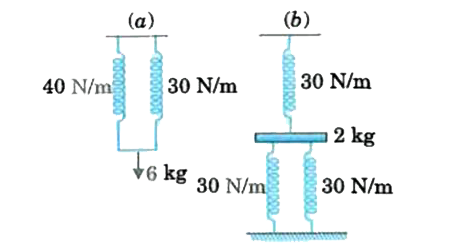The springs shown are identical. When A =4 kg , the elongation of spring is 1 cm . If B = 6kg , the elongation produced by it is 
4 cm
3 cm
2 cm
1 cm
The correct Answer is:B
F=kx⇒mg=kx⇒m∝kx
m1m2=k1k2×x1x2⇒46=kk/2×1x2
⇒x2=3cm.
Similar Questions
When a mass of 4 kg is hung from the lower and of a spring.IF elongates by 1cm.(i) What is the force constant of the spring? (ii) If a load of 2kg is hung from the lower end of the spring , then find its elongation.
View SolutionCalculate the elongation produced in each spring in the following cases, (a). (b) and (c ) if springs are identical and having force constant of 150 Nm^(-1) .
View SolutionCalculate the elongation produced in each of the spring combinations:

View SolutionA block of 2 kg is suspended from the ceiling through a massless spring of spring constant k = 100 N/m. What is the elongation of the spring? If another 1 kg is added to the block, what would be the further elongation?
View SolutionA block of 2 kg is suspended from the ceiling through a massless spring of spring constant k = 100 N/m. What is the elongation of the spring? If another 1 kg is added to the block, what would be the further elongation?
View SolutionA block of 2 kg is suspended from the ceiling through a massless spring of spring constant k=100 N/m. What is the elongation of the spring? If another 1 kg is added to the block, what would be the further elongation?
View SolutionA block of 2 kg is suspended from the ceiling through a massless spring of spring constant k = 100 N/m. What is the elongation of the spring? If another 1 kg is added to the block, what would be the further elongation?
View SolutionA block of 2 kg is suspended from the ceiling through a massless spring of spring constant k = 100 N/m. What is the elongation of the spring? If another 1 kg is added to the block, what would be the further elongation?
View Solution